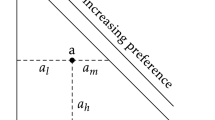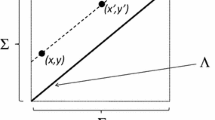Abstract
An experiment with two replications is reported in which subjects attempt to evade prediction by a computer over aseries of binary choices. The computer routines include a control condition of complete randomization and four routines that make predictions on the basis ofinformation obtained from individual subjects concerning conditional probabilities of event choice. Prediction routines use information from the last trial only (same or different, won or lost) or for the two previous trials (eight combinations of same or different, won or lost). Two routines maximize predictions and two match predictions with estimates of conditional probabilities. Results show a consistent effect of both main variables on gain in predictive efficiency and also a significant interaction.
Similar content being viewed by others
References
EPSTEIN, R.A. 1967. The theory of gambling and statistical logic. New York: Academic Press.
FELDMAN, J., & HANNA, J.F. 1966. The structure of responses to a sequence of binary events. Journal of Mathematical Psychology, 3, 371–387.
FRIEDMAN, M.P., CARTERETTE, E.C., & ANDERSON, N.H. 1968. Long-term probability learning with a random schedule of reinforcement. Journal of Experimental Psychology, 78, 442–455.
GAMBINO, B., & MYERS, J.L. 1967. Role of event runs in probability learning. Psychological Review, 74, 410–419.
HAKE, H.W., & HYMAN, R. 1953. Perception of the statistical structure of a random series of binary symbols. Journal of Experimental Psychology, 45, 64–74.
JARVIK, M.E. 1951. Probability learning and a negative recency effect in the serial anticipation of alternative symbols. Journal of Experimental Psychology, 41, 291–297.
LINDMAN, H. & EDWARDS, W. 1961. Unlearning the gambler’s fallacy. Journal of Experimental Psychology, 62, 630.
LORDAHL, D.S. 1970. An hypothesis approach to sequential predictions for binary events. Journal of Mathematical Psychology, 7339–361.
RESTLE, F. 1961. Psychology of judgment and choice. New York: Wiley.
SCHEIBE, K.E. 1978. The psychologist’s advantage and its nullification. American Psychologist, 33, 869–881.
SCHEIBE, K.E. 1979. Mirrors, masks, lies, and secrets. New York: Praeger.
SCHEIBE, K.E., & ERWIN, M. 1979. The computer as alter. Journal of Social Psychology, 108, 103–109.
SCRIVEN, M. 1965. An essential unpredictability in human behavior. In B.B. Wolman (Ed.), Scientific psychology. New York: Basic Books.
SIEGEL, S. 1964. Choice, strategy, and utility. New York: McGraw-Hill.
WAGENAAR, W.A. 1972. Generation of random sequences by human subjects. Psychological Bulletin, 11, 65–71.
WILLIAMS, C.D., HARTLEY, R.E., TAYLOR, J.L., & HARRINGTON, R.T. 1975. Event patterns in sequential choice behavior. American Journal of Psychology, 88, 33–47.
Author information
Authors and Affiliations
Rights and permissions
About this article
Cite this article
Scheibe, K.E., Bloom, A.J. An Empirical Assault on the Predict Ability of Sequential Binary Choices. Psychol Rec 29, 487–500 (1979). https://doi.org/10.1007/BF03394638
Published:
Issue Date:
DOI: https://doi.org/10.1007/BF03394638



